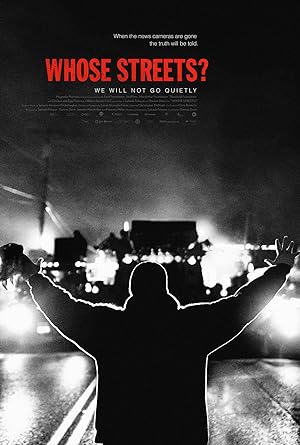Whose Streets? is a documentary that uses on camera interviews and footage shot by citizen journalists who are residents of Ferguson, Missouri, to critique and protest the extrajudicial execution of Michael Brown, the police reaction to largely nonviolent protests in a residential community and the national mainstream news coverage of the community. I actually relied on This Week in Blackness podcast, which is based in Oakland, CA and New York, but went to Ferguson on the ground coverage of the protests so I was excited to see this film and paid to see it in theaters. My main criticism of documentaries, including this one, is that if the filmmaker is too close to the subject, then the documentary may not communicate its message clearly to a viewer who either knows nothing about the subject matter or does not already support that message.
Whose Streets? is an earnest and passionate first film by Sabaah Folayan and Damon Davis. The last half hour is the strongest part of the documentary, but the first hour is not always cohesive or coherent even as a preach to the choir documentary and not a documentary seeking to convince viewers of their position. It is an extremely rough first draft that can feel repetitive and strident as people’s noble positions and rhetoric are presented before we have any understanding of their lives. It takes awhile to figure out who is being interviewed, and male voices dominate the early part of the film.
Whose Streets? does succeed at showing how the principles of our Constitutional forefathers would be received if the messenger belonged to a different demographic. The documentary conveys the idea of Ferguson as a neighborhood being invaded as people are being tear-gassed in their backyards and street memorials are burned down. When residents respond by using the full range of nonviolent protest, which occasionally but rarely in comparison to mainstream news coverage, includes destruction or damage to property (Boston Tea Party), and exercise all their liberties, including freedom of speech and assembly, the reaction is shockingly, but unsurprisingly equally as brutal. The revolution will be not be televised, but it will be recorded.
I was grateful for the nuanced moments that counter prevailing notions of who are allies. A lesbian white woman who claims to be the adopted mother of black children allegedly drives into protestors and describes their chanting as tribal. Black people are always characterized as homophobic, but the community is represented as celebrating “revolutionary love” between two black women, who become the anchor of the movement. There is an emotionally resonant moment when protestors gently acknowledge solidarity with those in blue while protesting, and a single person in blue responds emotionally.
I was frustrated that the documentary’s goal did not include an objective factual account of what happened to Mike Brown. I wanted Whose Streets? to provide context for the alleged surveillance video and show the Ferguson Police Department constantly shifting positions in press conferences. I lean to respectability politics, which I think the Ferguson residents would still succeed at playing. The documentary does include a critique of doing things the old way and vociferously advocates for the old guard giving way to the new so that is my agenda, not the filmmakers or the movement.
If you end up watching Whose Streets? at home, you will not be fully engaged because of the structural flaws, which is a shame because I can see many viewers checking out just when the documentary is improving. The documentary achieved its goal and has strong content, but overall, the film is weak in terms of editing and framing of its narrative.
Stay In The Know
Join my mailing list to get updates about recent reviews, upcoming speaking engagements, and film news.





